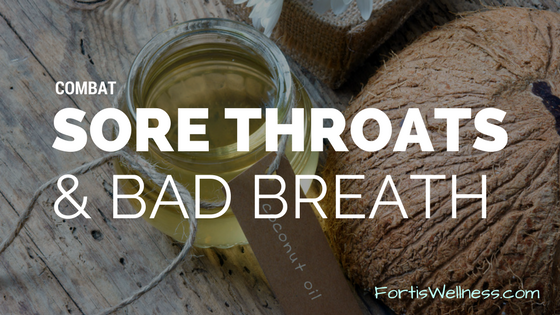
Communication is key in the workplace. Don’t let a sore throat or bad breath inhibit that interpersonal connection.
There are many underlying things that can lead to a sore throat or bad breath. For example, weak stomach acid causes food to rancidity in the gut, leading to foul breath and body odor. However, provided some of those underlying digestive and immune related issues are addressed, oil pulling is a great adjunct to keeping bad bacteria in your mouth, throat, and body under control.
Oil pulling is a procedure that involves swishing oil in the mouth for oral and systemic health benefits. It can treat weakness of the teeth, gums, jaws and is an all around detoxifier. Some have even found oil pulling as an effective way to whiten their teeth.
How does it work?
Bacteria has a lipid (fat) bilayer. Like attracts like. Think about what happens when you put olive oil in a pot of water when cooking spaghetti (sprouted quinoa spaghetti, of course!). The oil separates from the water and binds to itself.
Now, let’s get back to oil pulling…
The most common oils to use for this procedure are sesame, sunflower, or coconut oil. When you swish the oil of your choosing around in your mouth with a bit of water (optional), the bacteria lipid bilayer is attracted to the lipid oil in your mouth and the oil literally pulls the bacteria off of your teeth, gums, and upper throat. It is important to spit the oil in your mouth out after you swish for a few minutes instead of swallowing it to eliminate the bacteria.
Is there evidence to support oil pulling?
A 10 day study was conducted by Asokan, et al. (2009) to evaluate the effect of oil pulling with sesame oil on plaque-induced gingivitis and to compare its efficacy with chlorhexidine mouthwash (anti-microbial).
The study included a total of 20 adolescent boys who were the same age with plaque-induced gingivitis. They were divided randomly into two groups of 10 for the study, oil pulling group (Group I) and the control and chlorhexidine group (Group II). Plaque index and modified gingival index scores were recorded for all 20 subjects and baseline plaque samples were also collected.
There was a statistically significant reduction of the pre- and post- values of the plaque and modified gingival index scores in both the study and control groups (p< 0.001 in both). The oil pulling therapy showed a reduction in the plaque index, modified gingival scores, and total colony count of aerobic microorganisms in the plaque of adolescents with plaque-induced gingivitis. This indicates that oil pulling is equally as effective at reducing microorganisms in the mouth as chlorhexidine.
Great! How do I start oil pulling?
If you want to start integrating oil pulling into your self-care routine, doing it while you are in the shower is the simplest way. If you are a shower singer, you might want to do it while you are getting dressed instead.
How to begin oil pulling:
- Choose some high quality (organic, virgin, cold-pressed/unrefined) sesame, sunflower, olive or coconut oil in your mouth prior to getting in the shower. Avoid corn oil, canola oil, cottonseed oil and soy oil, and oils that go rancid very quickly such as flax oil.
NOTE: The oils can double in size while it draws in the bacteria and mixes with your saliva, so do not OVER FILL your mouth.
- Swish the oil in your mouth for 5-10 minutes, 20 if you are truly ambitious and want to really whiten your teeth.
- Try not to swallow or gargle the oil. You are trying to eliminate the toxins, not ingest them.
- Be patient.
- When you’re finished, spit out the oil in the trash. An old shampoo or supplement bottle works well for this if you are in the shower, and you can throw it away when full. Spitting it in a lined trash can is another option. However, you dispose of it, just avoid spitting it down the drain, especially if you are using a saturated fat like coconut oil. You don’t want to clog your drain!
Afterwards, you can rinse your mouth with a little warm water and brush your teeth as normal.
Do this everyday for at least 30 days. You could start seeing results in as little as a couple days, but depending on the condition of your oral health, it may take up to 30-60 days to see your desired results.

Leave Your Comments
blog comments powered by Disqus